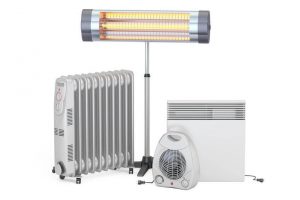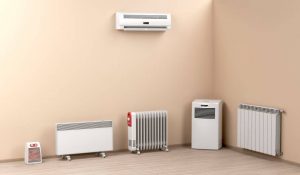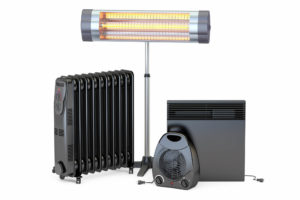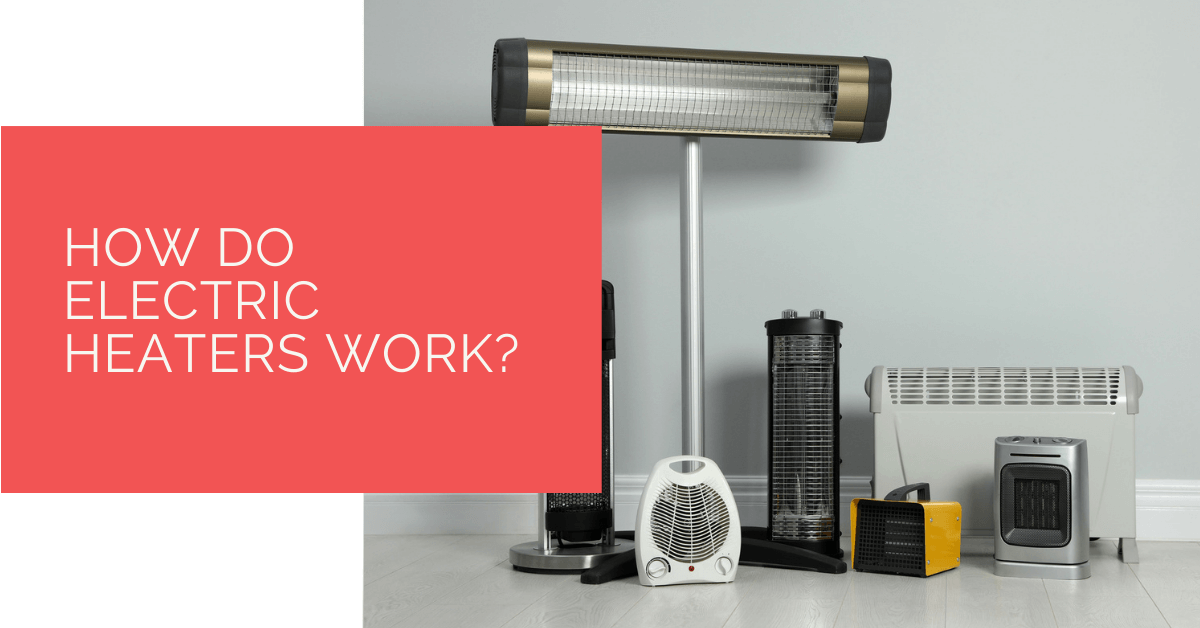Most of us seldom understand the inner workings of our day-to-day electrical appliances. One such appliance that we know little about is the electric heater.
Electric heaters are commonly used in most households as a source of heat. However, if you are curious to know more about how they work, then you are at the right place.
Read on as we understand how.
Key Takeaways
- Electric heaters work based on resistive heating, where electricity passes through a material with resistance, producing heat. The higher the resistance, the more heat is generated.
- The central component in electric heaters is the resistor, typically made of carbon, which regulates current flow and protects against voltage spikes.
- Electric heaters use two main types of heating: convection, which warms air that circulates via fans, and radiant, which emits heat waves absorbed by people in the room. The type of heating method varies depending on the heater’s design and purpose.
The concept of resistance
To understand the working of electric heaters, it is imperative to discuss fundamental physics which is key to the working: resistance.
 Resistance is observed when electricity flows through a conductive material, in this case, a length of metal wire. The electrons come in contact with the particles present in the metal, thereby slowing down the passing of current.
Resistance is observed when electricity flows through a conductive material, in this case, a length of metal wire. The electrons come in contact with the particles present in the metal, thereby slowing down the passing of current.
If the wire used has a higher resistance level, it will generate a more significant amount of heat. Virtually all devices that function as electric heating systems employ resistive heating, also referred to as Joule heating, to create warmth.
Resistance is often perceived as a bad quality; however, this very resistance helps produce heat for electric heaters. Materials designed with electrical resistance do not allow electricity to pass through them very quickly.
This leads to a more significant amount of friction when electricity tries to pass via the resistant material and results in the production of heat. So, the higher, the greater the heat produced.
The resistor in electrical heaters
The resistor is considered the central piece in an electrical heater that has many purposes. It is usually made up of carbon and regulates the flow of electricity within the circuit. It ensures that all parts of the heater receive the required voltage.
In addition to regulating the flow of current, it also protects the device against voltage spikes that could lead to damage. Therefore, the quality of the resistor is a deciding factor in the efficiency of the device and its life.
Types of resistors
There are different types of resistors available in the market. The most common types of registers used are:
Ceramic cylinder resistors
Ceramic makes an excellent insulator since it is a conductor of heat. So, for a resistor that is ceramic, low to moderate power can be used.
These heaters function based on convection heating wherein the ceramic plates warm the air with the help of a fan. The external body of the device remains cool, and the ceramic heating element is long-lasting.
This makes them the ideal choice if you have kids and pets at home, as it helps avoid any accidental injuries.
Mica embedded wire resistors
For applications that require lower power, mica embedded wire resistors are the go-to option. It provides higher resistance, thereby generating the required heat efficiently.
Tubular core resistors
Tubular core resistors come in different shapes depending on the usage. The diameter of the tubular core resistor is decided based on where it is used. This variant is capable of handling higher power loads.
Tubular resistor with magnesium oxide powder
One of the versions of a tubular resistor is the magnesium powder model. The magnesium oxide provides insulation to the electrical wiring and helps conduct thermal energy effectively.
Types of heating based on heat transfer
Electric heaters function on two significant types of heating, namely convection heating and radiant heating.
Convection heating
A heater that functions on the convection heating principle requires a medium to facilitate heat transfer. Such a heater allows air to pass via the heater which gets warmed and rises and travels on molecules as it gets heated up.
This passing of air through a convection heater can either be facilitated naturally or with the help of a fan.
Radiant heating
Heaters that work on the principle of radiant heating do not require air to pass through the surface. Instead, the heat is passed on in radiant heat waves. These heat waves are then absorbed by people present in the room.
The role of the heating coil in the working of electric heaters
 When you turn on a heater, the electric current passing through the system helps heat the wire component that has nichrome, also known as the heating oil. As the amount of electricity passing through the resistor increases, a more considerable amount of heat is produced. Thus, the term resistance heating units are derived from this working methodology.
When you turn on a heater, the electric current passing through the system helps heat the wire component that has nichrome, also known as the heating oil. As the amount of electricity passing through the resistor increases, a more considerable amount of heat is produced. Thus, the term resistance heating units are derived from this working methodology.
Additionally, the fan present in a heater pulls the air from the atmosphere into the heater. This air is then forcefully passed over the heating element, converting it to warm air which is then released into the room.
This process of pulling in air from the atmosphere and increasing its temperature by passing overheating coils is referred to as convection heating. This is more suitable for larger spaces as air is forced through a fan and can heat more area in a lesser amount of time.
In the absence of a fan, the air passes over the coil and is released from the heater. As discussed, this is a form of radiant heating. Devices that function in this manner are more suitable for smaller rooms and areas.
The device heats the air that is present around it. It would take a more considerable amount of time to warm up a larger space effectively. The most common type of radiant heater is the electric baseboard. This model is in economic choice and works in the principle of natural convection.
The different types of electric heaters
Irrespective of the type of device, the basic principle remains common. The critical difference lies in the size and layout of the wiring. Almost all electric heating systems run on the code of Joule heating.
Resistive heating is used in several ways to give rise to multiple heating options. Discussed below are the most common methods used.
Convection heaters
Appliances that generate heat by using the process of convection generally have heating elements that are exposed. This is done to maximize the contact after heating the element with air. The heating element is usually fixed at the device’s base, which is observed when it comes to panel heaters. On the contrary, they are also used with a fan which helps convert cold air into warm air by passing it through the system.
The primary benefit of this model is that the air surrounding the device quickly gets heated up. If you need to warm up a particular space in less time, this is the best option.
Electric radiators
An electric radiator is generally made of aluminium or steel and have fins attached to the exterior. The heating element is completely covered and hidden within the device. Since the heating element is covered, the entire device heats up and is conducted into the room.
Underfloor heating/infrared panels
 In both of these systems, the heating element is completely enclosed. However, the heating element’s layout is entirely different from other products such as electric radiators.
In both of these systems, the heating element is completely enclosed. However, the heating element’s layout is entirely different from other products such as electric radiators.
In these heaters, the length of the wire is heated to produce warmth over the entire surface area. This gives rise to a mellow warmth that is comfortable. Although it serves the purpose, these devices take a more extended amount of time to heat the space.
Additionally, it is advisable to leave them on at a lower setting for a more extended period rather than switching them off completely.
Oil-filled radiators
Electric towel rails and other radiators fall under the category of oil-filled products. The heating element is submerged in oil within the device. When this element is heated, the warmth is transferred to the oil, which then flows around the appliance in what is known as a liquid convection cycle.
The heat is then evenly spread throughout the surface of the device and eventually emitted into the room.
Ceramic radiators and ceramic heaters
The metal heating element is stored within a ceramic case. This helps to retain and maximize the heat generated. Ceramic is an excellent conductor of heat, which allows the device to stay hot for a more extended period and emits heat of greater intensity. This makes it the ideal choice for heating applications.
Moreover, ceramic is a durable material that can withstand higher temperatures for a more extended period without getting damaged.
Heat Pump Source: Reliable Heating and Cooling Solutions
At Heat Pump Source, we take pride in our unwavering commitment to serving the UK with top-tier HVAC solutions. From the efficiency of heat pumps and the cool relief of air conditioning to the warmth of boilers, radiators, and underfloor heating, our dedicated team is always at the forefront of innovation. We understand the unique needs of every household and business, and we strive to provide dependable health and cooling products and services that are tailored just for you. Ensuring your comfort and satisfaction is our utmost priority. Whether you have questions, need guidance, or require support, we’re always here to assist. Please don’t hesitate to contact us; we’re eager to be of service.
Heat Pump Source: Reliable Heating and Cooling Solutions
At Heat Pump Source, we take pride in our unwavering commitment to serving the UK with top-tier HVAC solutions. From the efficiency of heat pumps and the cool relief of air conditioning to the warmth of boilers, radiators, and underfloor heating, our dedicated team is always at the forefront of innovation. We understand the unique needs of every household and business, and we strive to provide dependable health and cooling products and services that are tailored just for you. Ensuring your comfort and satisfaction is our utmost priority. Whether you have questions, need guidance, or require support, we’re always here to assist. Please don’t hesitate to contact us; we’re eager to be of service.
Conclusion
The working of electric heaters is a reasonably simple phenomenon. Resistive heating is highly effective and can be employed to achieve different results. Additionally, electric heaters possess several advantages that make them the best suitable choice for heating devices.
In addition to providing the device with varying levels of efficiency, they also help prolong the life of the device. These heaters, therefore, make a wise one-time investment that helps provide warmth and comfort throughout the year.
About the Author
At Heat Pump Source, our articles are the product of a collaborative effort among a team of highly skilled HVAC experts. Our dedicated professionals, hailing from diverse backgrounds in heating, ventilation, air conditioning, and refrigeration, contribute their extensive knowledge and experience to every piece of content. This multidisciplinary approach ensures comprehensive coverage. Our commitment is to deliver authoritative, reliable, and tailored advice to meet the unique needs of every household and business across the UK.

